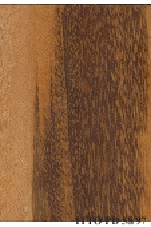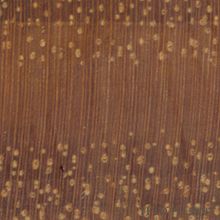
GONçALO-ALVEZ, JOBILLO (Astronium graveolens)
Trade Name
Gonçalo-Alvez, Jobillo
Scientific Name
Astronium graveolens Jacq.
Family
ANACARDIACEAE
Common Names
Ron Ron; Palo De Culebra; Palo De Cera; Jobillo; Guarita; Gonçalo Alves (Brazil); Gateado; Frijolillo; Ciruelillo; Potrico; Zorro; Zebra Wood; Yomato; Vermelho (Brazil); Ubatin; Tibigaro; Rorón; Quebracho; Quebracha; Hormigo; Locuswood; Jenjiura; Guasango; Urunday; Tiger Wood; Bossona; Bois De Zebre; Urunday-Pará (Brazil); Mura; Zorrowood; Zebrawood; Tigerwood; Brazilian Kingwood; Gonçalo Alves Rajado Branco (Brazil); Guarabu Encirado (Brazil); Guarabu Bata (Brazil); Guarabu Rajado (Brazil); Jejuira (Brazil); Gusanero; Muiraquatiara (Brazil); Yoke; Kingwood
Scientific Name Synonyms
Astronium planchonianum Engl.; Astronium graveolens var. planchoniana Engl.; Astronium graveolens var. inodorum Triana & Planch; Astronium graveolens var. brasiliensis Engl; Astronium fraxinifolium var. glabrum Engl.; Astronium fraxinifolium Schott ex Spreng.
Description Of The Tree
Botanical Description
The trees can reach heights of 40 m, with trunk diameters ranging from 60 to 100 cm or more. They develop well-formed and cylindrical boles clear up to two thirds or more of the height of the tree. This species is reported to present narrow buttresses of
Natural Habitat
Astronium species are found in primary, rarely in secondary, forests. It is also reported in Bolivia, in the humid savanna forests.
Natural Distribution
Central America and northern South America. It is common from Mexico to Bolivia (Beni).
Wood Identification
Anatomic Description Of Wood
Wood diffuse porous. Vessels solitary and in short radial multiples. Tyloses common. Vessels per mm2 10 to 20 (abundant). Simple perforation plates. Vessel-ray pits coarse in marginal rows. Vessel-ray pits larger than the intervessel pits. Occasionally intervess Axial parenchyma absent or extremely rare, non visible with magnifying glass (8x). Paratracheal axial parenchyma scanty and/or vasicentric. Occasionally prismatic crystals in non-chambered axial parenchyma cells. 3 to 4 cells per parenchyma strand. Rays 1 to 4 seriate. Larger rays more than 4 seriate. Prismatic crystals in the ray cells. Homogeneous rays and/or sub-homogeneous rays (all ray cells procumbent). Heterogeneous rays and/or multiseriate heterogeneous rays. Body ray cells procumbent with mostly Septate fibers present. Fibers with simple to minutely bordered pits.
-
 Wood Macro Photo Tangential Plane
Wood Macro Photo Tangential Plane
-
 Wood Micro Photo Of Transversal Section
Wood Micro Photo Of Transversal Section
Availability
Cites Status
Unrestricted
General Wood Description
Odor
It has no discernible odor or taste.
Color
The sapwood is clearly demarcated from the heartwood. The heartwood is usually reddish-brown or orange brown, with dark brown streaks, darkening after exposure.
COLOR INDEX (1=Black, 7=Light yellow,white)
2
Grain
Grain varies, it is straight to wavy or interlocked.
Texture
Texture is fine to medium.
Natural Durability
It is very durable and it is resistant to wood rotting fungi. It is also resistant to termites and dry-wood insects attacks.
Natural durability index (1= Very high durability, 7=Vey low durability)
1
Resistance To Impregnation
It is reported to be extremely resistant to preservative treatment.
Wood Physical Properties
Basic Density or Specific Gravity (O.D. weight/vol. green) (g/cm³)
0.86
Air-dry Density (Weight and volume at 12%MC) (g/cm³)
1.00
Total shrinkage Tangential (Saturated to 0%MC) (%)
7.8
Total shrinkage Radial (Saturated to 0%MC) (%)
4.6
Drying Defects
Ease of Drying: It is reported to be easy to moderately difficult to air season, drying is rated as moderate to rapid. Drying Defects: Slight warping and checking.
Recommended Dry Kiln Schedule
US-T3-C2; UK-C
Dimensional stability ratio (Total Tangential Shrinkage %/Total Radial Shrinkage %)
1.7
Wood Chemical Properties
Wood Mechanical Properties
Bending Strength (MOR),12%MC (kgf/cm²)
1502
Stiffness (MOE) 12%MC (kgf/cm²)
183812
Compression parallel to fiber 12%MC (kgf/cm²)
752
Compression perpendicular to fiber 12%MC (kgf/cm²)
136
Shear strength radial 12%MC (kgf/cm²)
132
Janka hardness (side) 12%MC (kgf)
1068
Janka hardness (end grain) 12%MC (kgf)
1043
Workability
Sawing
It is a very heavy wood and it requires power for sawing.
Rotary Veneer Cutting
This species is interesting for slicing.
Sliced Veneer
This species is interesting for slicing.
Blunting Effect
Wood of this species produces a moderate blunting effect. Tools reinforced with carbide-tipped blades and cutters are recommended.
Planing
Planing operations are difficult, with rough surfaces. Frequently torn grain is reported.
Turning
30
Nailing
Pre-boring is recommended in nailing.
Gluing
Special precaution is recommended in gluing because of the extractives content.
Sanding
The wood is reported to be generally easy to sand.
Finishing
No grain filling is required to obtain a smooth finish.
Polishing
The wood can be polished and finished very easily.
Substitute Species
Dalbergia spp.
REFERENCED USES
End Uses Summary
EXTERIOR GENERAL, bridges, paling, rails, crossarms, crossties, HOUSING GENERAL, beams, joists, boards, flooring, frames, steps, panelling, FURNITURE AND CABINETS, common furniture, PLYWOOD AND VENEER, Decorative veneer, TURNING, ornaments, turned furniture, cutlery, TOOLS, tool handles, agricultural tools, PACKING, heavy packing, CONTAINERS, truck bodies, truck flooring, NAVAL CONSTRUCTION, boat deck
Exterior General
- 1 - Tabela de resultados de ensaios fisicos e mecanicos
Bridges
- 2 - 25 madeiras da amazonia de valor comercial, caracterizacao, macroscopica, usos comuns e indices qualificativos
Paling Fence Pickets
- 4 - Estudo dendrologico e determinacao das caracteristicas fisicas e mecanicas da bicuiba
Rails
- 6 - Physical and mechanical properties of Eucalyptus deglupta Blume grown in Costa Rica
Crossheads Crossarms
- 7 - Maderas latinoamericanas. II, Quercus alata Q. costaricensis y Q. eugeniaefolia
Crossties
- 8 - Maderas latinoamericas. III, Podocarpus standleyi ,Podocarpus oleifolius, Drims granadensis, Magnolia poasana y Didymopanax pittieri
General Housing
- 10 - Silica in Timbers
Beams
- 11 - Prospect: The wood database
Joists
- 12 - Tropical timbers of the world. Part I-Tropical American Species
Boards
- 13 - Dry kiln schedules for commercial woods. Temperate and tropical. Section III. Latin American (Mexico, Central, and South America) Woods–Conventional Temperatures
Flooring
- 14 - Handbook of Hardwoods
Frames
- 16 - Woods of the World
Steps
- 17 - Tree Conservation Database
Paneling
- 18 - W3TROPICOS Missouri Botanical Garden
Furniture Cabinets
- 21 - Tropical timbers of the world. Part III-Southeast Asian and Oceanian Species.
Furniture, Common
- 23 - Handbook of Hardwoods
Panels, Veneers
- 25 - Directory of Timber Trade Malaysia
Decorative veneer
- 28 - Ministry of Agriculture, Fisheries & Forest of Fiji
Turning
- 30 - Embassy of Honduras in Japan
Ornaments
- 31 - Embassy of Colombia in Japan
Turned Articles
- 32 - Embassy of Cote d`Ivoire in Japan
Knife Handles
- 33 - Embassy of Gabon in Japan
Tools
- 42 - Utilización Industrial de Nuevas Especies Forestales en el Perú.
Tool Handles
- 43 - Maderas de Bolivia (Características y Usos de 55 Maderas Tropicales)
Agricultural Tools
- 44 - Atlas of Peruvian Woods
Packing
- 45 - Recopilación y Análisis de Estudios Tecnológicos de Maderas Peruanas
Heavy Packing
- 47 - Arvores Brasileiras
Truck Body
- 53 - Timbers of the New World
Truck Flooring
- 54 - Bulletin of the Government Forest Experiment Station N.157: Identification of Tropical Woods
Shipbuilding
- 55 - Tropical Timber Atlas of Latin America
Boat Decking
- 59 - Programa Nacional de uso Sostenible de los Bosques e Incremento a las Exportaciones.
Please Provide Information To View Producer Information